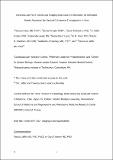Intravascular fibrin molecular imaging improves the detection of unhealed stents assessed by optical coherence tomography in vivo
Author(s)
Hara, Tetsuya; Ughi, Giovanni J.; McCarthy, Jason R.; Erdem, S. Sibel; Mauskapf, Adam; Lyon, Samantha C.; Fard, Ali M.; Edelman, Elazer R.; Tearney, Guillermo J.; Jaffer, Farouc A.; ... Show more Show less
DownloadFTP11 v32 R1 EHJ CLEAN with supplements.pdf (1.735Mb)
OPEN_ACCESS_POLICY
Open Access Policy
Creative Commons Attribution-Noncommercial-Share Alike
Terms of use
Metadata
Show full item recordAbstract
Aims: Fibrin deposition and absent endothelium characterize unhealed stents that are at heightened risk of stent thrombosis. Optical coherence tomography (OCT) is increasingly used for assessing stent tissue coverage as a measure of healed stents, but cannot precisely identify whether overlying tissue represents physiological neointima. Here we assessed and compared fibrin deposition and persistence on bare metal stent (BMS) and drug-eluting stent (DES) using near-infrared fluorescence (NIRF) molecular imaging in vivo, in combination with simultaneous OCT stent coverage.
Methods and results: Rabbits underwent implantation of one BMS and one DES without overlap in the infrarenal aorta (N = 20 3.5 × 12 mm). At Days 7 and/or 28, intravascular NIRF-OCT was performed following the injection of fibrin-targeted NIRF molecular imaging agent FTP11-CyAm7. Intravascular NIRF-OCT enabled high-resolution imaging of fibrin overlying stent struts in vivo, as validated by histopathology. Compared with BMS, DES showed greater fibrin deposition and fibrin persistence at Days 7 and 28 (P < 0.01 vs. BMS). Notably, for edge stent struts identified as covered by OCT on Day 7, 92.8 ± 9.5% of DES and 55.8 ± 23.6% of BMS struts were NIRF fibrin positive (P < 0.001). At Day 28, 18.6 ± 10.6% (DES) and 5.1 ± 8.7% (BMS) of OCT-covered struts remained fibrin positive (P < 0.001).
Conclusion: Intravascular NIRF fibrin molecular imaging improves the detection of unhealed stents, using clinically translatable technology that complements OCT. A sizeable percentage of struts deemed covered by OCT are actually covered by fibrin, particularly in DES, and therefore such stents might remain prothrombotic. These findings have implications for the specificity of standalone clinical OCT assessments of stent healing.
Date issued
2015-12Department
Harvard University--MIT Division of Health Sciences and TechnologyJournal
European Heart Journal
Publisher
Oxford University Press
Citation
Hara, Tetsuya, Giovanni J. Ughi, Jason R. McCarthy, S. Sibel Erdem, Adam Mauskapf, Samantha C. Lyon, Ali M. Fard, Elazer R. Edelman, Guillermo J. Tearney, and Farouc A. Jaffer. “ Intravascular Fibrin Molecular Imaging Improves the Detection of Unhealed Stents Assessed by Optical Coherence Tomography in Vivo .” European Heart Journal (December 18, 2015): ehv677.
Version: Author's final manuscript
ISSN
0195-668X
1522-9645